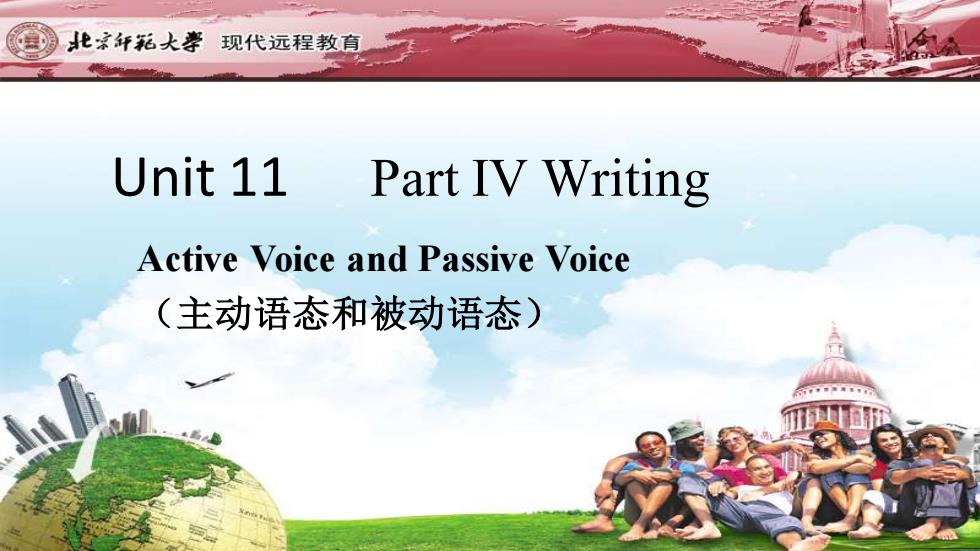
北京研拓大睾现代远程教育 Unit 11 Part IV Writing Active Voice and Passive Voice (主动语态和被动语态)
Unit 11 Part IV Writing Active Voice and Passive Voice (主动语态和被动语态)
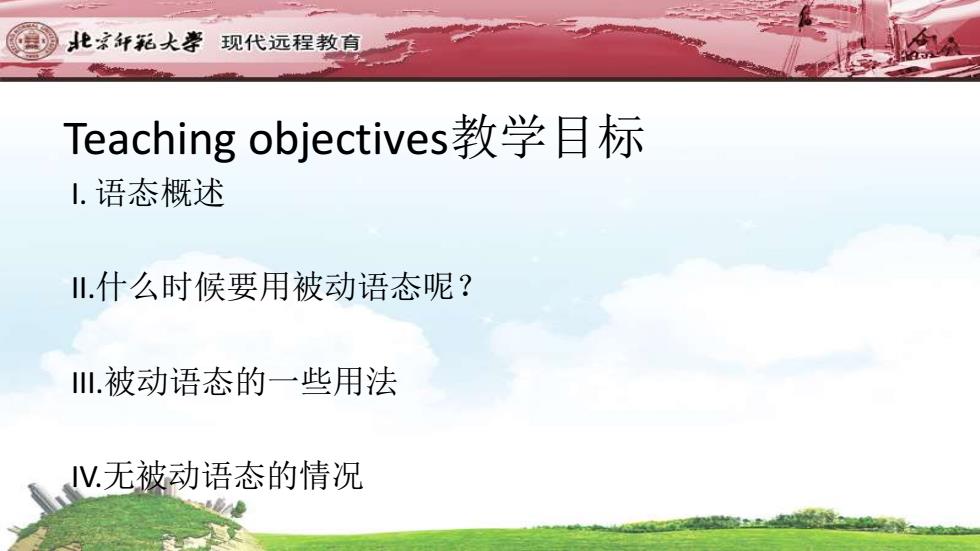
北京拓大 现代远程教育 Teaching objectives教学目标 1.语态概述 什么时候要用被动语态呢? l.被动语态的一些用法 Ⅳ.无被动语态的情况
Teaching objectives教学目标 I. 语态概述 II.什么时候要用被动语态呢? III.被动语态的一些用法 IV.无被动语态的情况

北京衹拓大孝现代远程教育 1.语态概述 英语的语态是通过动词形式的变化表现出来 的。 英语中有两种语态:主动语态和被动语态。 主动语态表示主语是动作的执行者。巧记为 :主动、主动、主去动。 例如:Many people speak English. 谓语:speak的动作是由主语many people来 执行的
I. 语态概述 英语的语态是通过动词形式的变化表现出来 的。 英语中有两种语态:主动语态和被动语态。 主动语态表示主语是动作的执行者。巧记为 :主动、主动、主去动。 例如:Many people speak English. 谓语:speak的动作是由主语many people来 执行的

北京拓大票 现代远程教育 1.语态概述 被动语态表示主语是动作的承受者,即行 为动作的对象。巧记为:被动、被动、主 被动。 例如:English is spoken by many people. 主语English是动词speak的承受者。 The door was opened.门被开了。 These songs are usually sung by children. 这些歌曲通常是儿童们唱的
I. 语态概述 被动语态表示主语是动作的承受者,即行 为动作的对象。巧记为:被动、被动、主 被动。 例如:English is spoken by many people. 主语English是动词speak的承受者。 The door was opened.门被开了。 These songs are usually sung by children. 这些歌曲通常是儿童们唱的
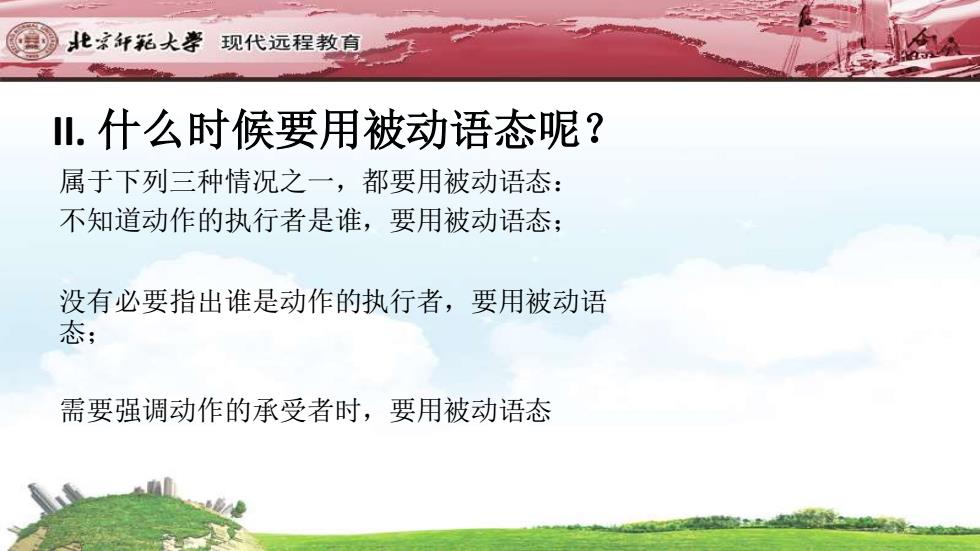
北京研拓大孝现代远程教育 川.什么时候要用被动语态呢? 属于下列三种情况之一,都要用被动语态: 不知道动作的执行者是谁,要用被动语态: 没有必要指出谁是动作的执行者,要用被动语 态 需要强调动作的承受者时,要用被动语态
II. 什么时候要用被动语态呢? 属于下列三种情况之一,都要用被动语态: 不知道动作的执行者是谁,要用被动语态; 没有必要指出谁是动作的执行者,要用被动语 态; 需要强调动作的承受者时,要用被动语态
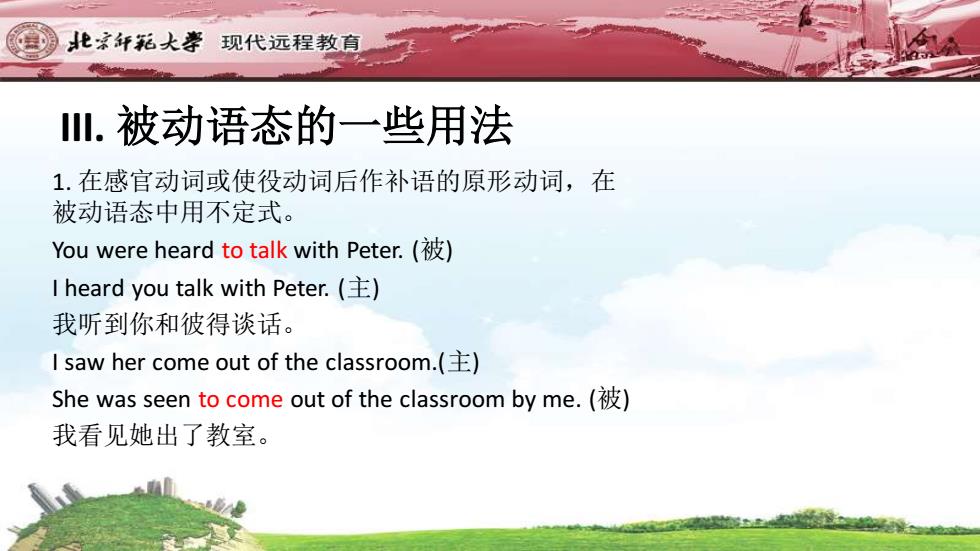
北京拓大睾 现代远程教育 Ⅲ.被动语态的一些用法 1.在感官动词或使役动词后作补语的原形动词,在 被动语态中用不定式。 You were heard to talk with Peter.( I heard you talk with Peter.(E) 我听到你和彼得谈话。 I saw her come out of the classroom.() She was seen to come out of the classroom by me.( 我看见她出了教室
III. 被动语态的一些用法 1. 在感官动词或使役动词后作补语的原形动词,在 被动语态中用不定式。 You were heard to talk with Peter. (被) I heard you talk with Peter. (主) 我听到你和彼得谈话。 I saw her come out of the classroom.(主) She was seen to come out of the classroom by me. (被) 我看见她出了教室

北京研拓大孝现代远程教育 Ⅲ被动语态的一些用法 2.主动句中的主语如果是people,we,you,they,somebody 等含糊地表示"人们"、"大家"的单词,变为主动句时, 通常删去"by",但原主语被强调者除外。如: People eat watermelons in the summer.(E) Watermelons are eaten in the summer.() 在夏天吃西瓜。 They set up this hospital in 1975. This hospital was set up in1975.这所医院建于1975年。 Only he can finish the job.只有他能完成这项工作。 The job can be finished only by him. 这项工作职能由他来完成
III.被动语态的一些用法 2.主动句中的主语如果是people, we, you, they, somebody 等含糊地表示"人们"、"大家"的单词,变为主动句时, 通常删去"by…",但原主语被强调者除外。如: People eat watermelons in the summer.(主) Watermelons are eaten in the summer.(被) 在夏天吃西瓜。 They set up this hospital in 1975. This hospital was set up in 1975. 这所医院建于1975年。 Only he can finish the job. 只有他能完成这项工作。 The job can be finished only by him. 这项工作只能由他来完成
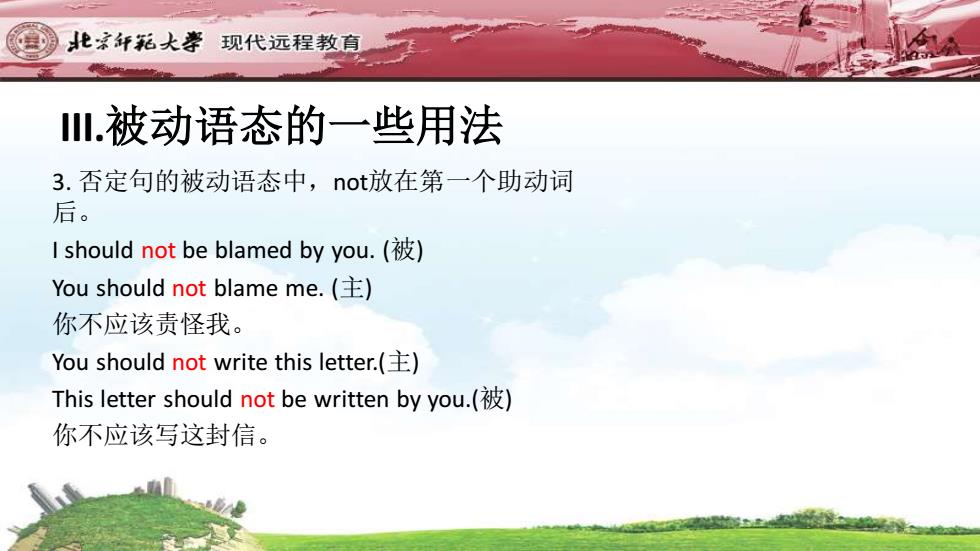
北京拓大 现代远程教育 l.被动语态的一些用法 3.否定句的被动语态中,not放在第一个助动词 后。 I should not be blamed by you.( You should not blame me.( 你不应该责怪我。 You should not write this letter.( This letter should not be written by you.( 你不应该写这封信
III.被动语态的一些用法 3. 否定句的被动语态中,not放在第一个助动词 后。 I should not be blamed by you. (被) You should not blame me. (主) 你不应该责怪我。 You should not write this letter.(主) This letter should not be written by you.(被) 你不应该写这封信

北京研拓大孝现代远程教育 .被动语态的一些用法 4.疑问句的被动语态中,用BE的对应形式代替DO。 Does she drive this car?() Is this car driven by her?() 她开这辆车吗? What shall we do next?() What will be done by us next?() 我们下一步做什么?
III.被动语态的一些用法 4.疑问句的被动语态中,用BE的对应形式代替DO。 Does she drive this car?(主) Is this car driven by her?(被) 她开这辆车吗? What shall we do next?(主) What will be done by us next?(被) 我们下一步做什么?

北京托大现代远程教育」 l被动语态的一些用法 5.祈使句的被动语态形式为: let+受词+be+过去分词。 Open the door please.() Let the door be opened please.( 请开门
III.被动语态的一些用法 5. 祈使句的被动语态形式为: let+受词+be+过去分词。 Open the door please.(主) Let the door be opened please.(被) 请开门